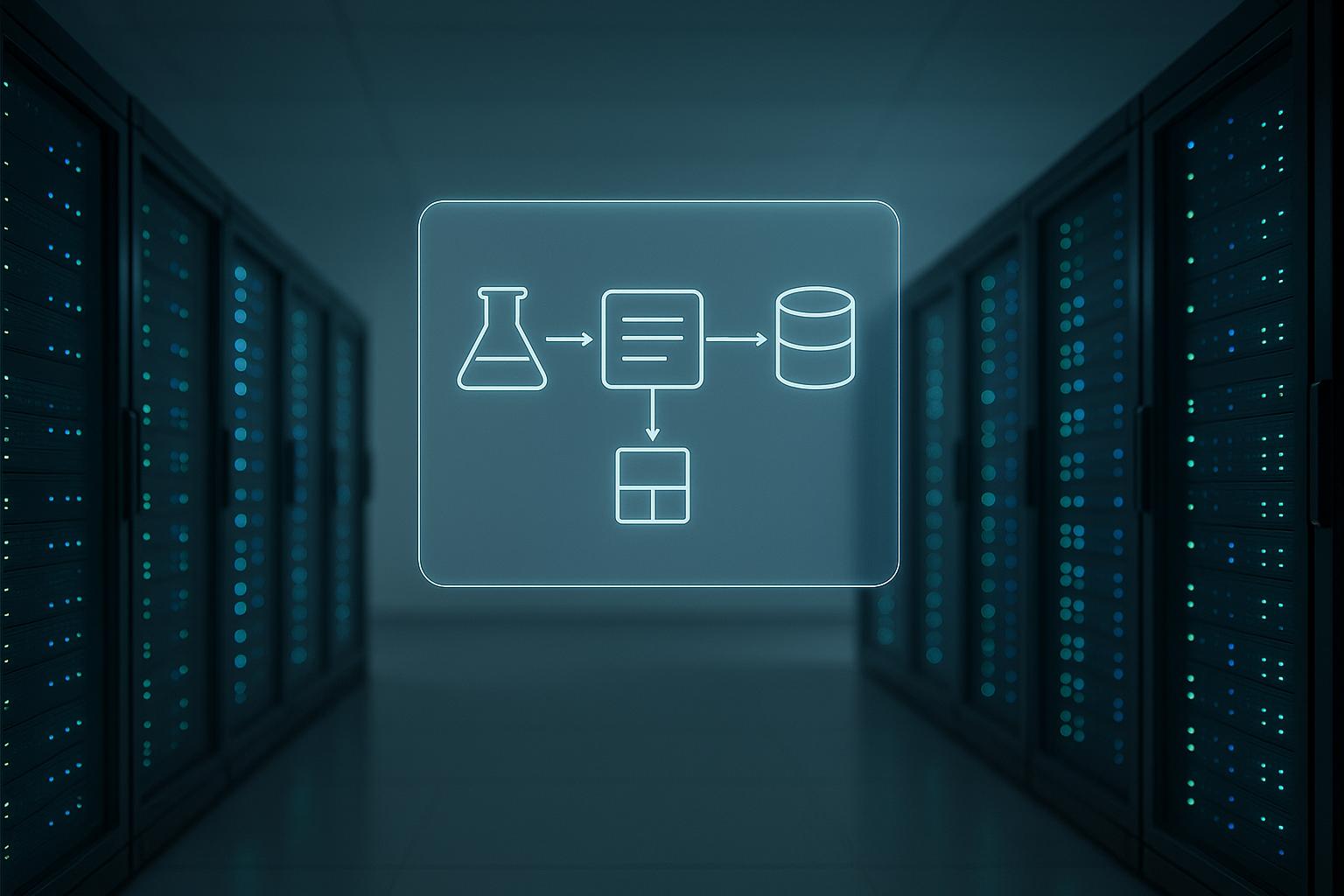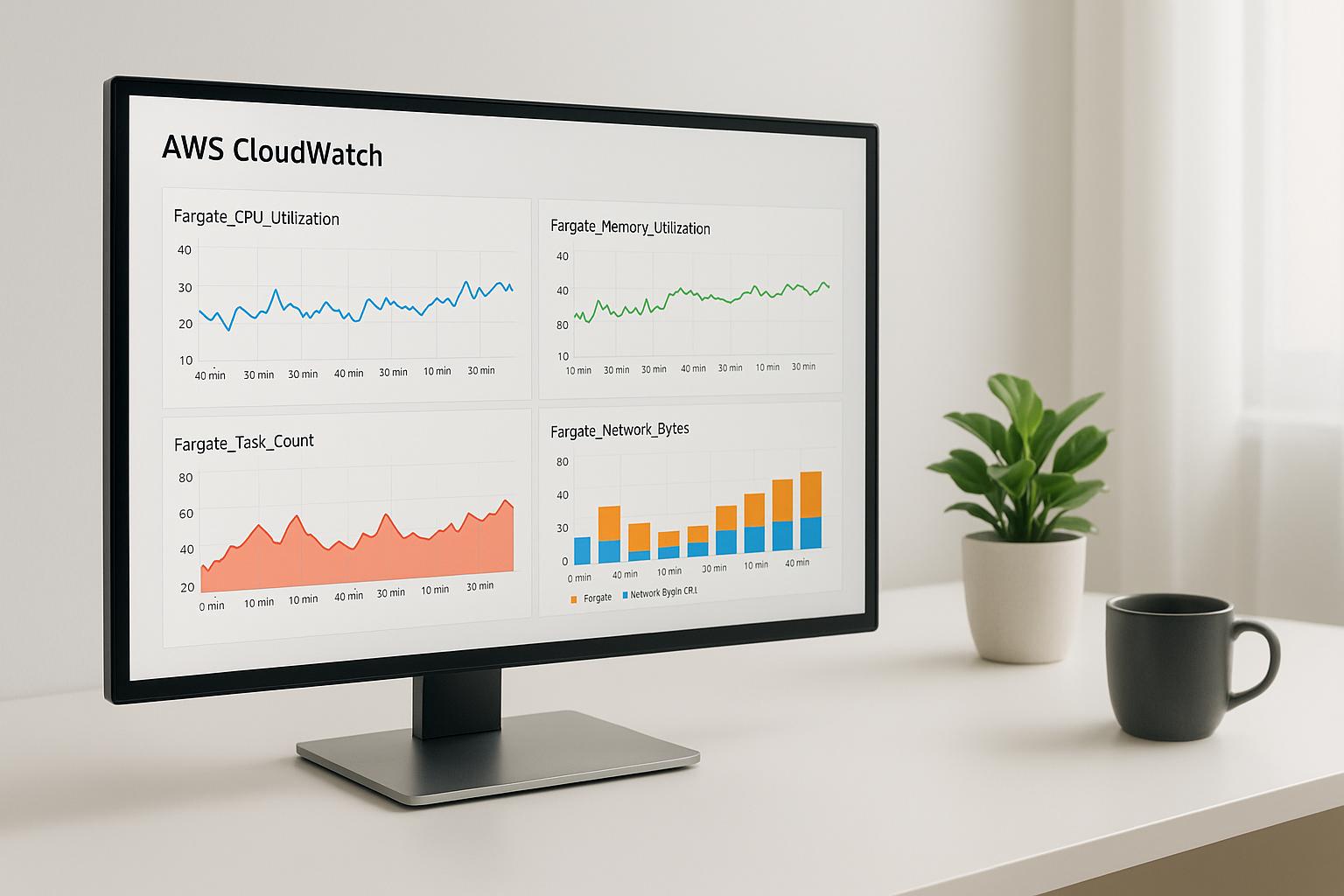Transforming data on AWS comes down to two main approaches: batch processing for scheduled, large-scale tasks and stream processing for real-time data handling. AWS provides several tools tailored to these needs:
- AWS Batch: Best for large, scheduled data jobs. Scales resources efficiently but isn't suitable for real-time tasks.
- AWS Lambda: Ideal for lightweight, event-driven tasks with fast execution. Limited by a 15-minute runtime cap.
- Amazon Kinesis Data Streams: Handles real-time data streams with low latency and high throughput. Requires shard management.
- Amazon Kinesis Data Firehose: Simplifies streaming data delivery and basic transformations. Automates scaling but offers less control.
- Amazon MSK: A managed Kafka service for high-throughput, complex event handling. Supports message replay and multiple consumer groups.
Each tool serves specific use cases, from scheduled ETL processes to real-time analytics. The choice depends on your workload's latency, volume, and processing needs. AWS services can also integrate to build end-to-end data pipelines.
| Tool | Best Use Cases | Latency | Scalability | AWS Integration |
|---|---|---|---|---|
| AWS Batch | Scheduled, compute-heavy jobs | Minutes to hours | Scales with job queues | Works with S3, RDS, CloudWatch |
| AWS Lambda | Event-driven tasks | Milliseconds | Automatic scaling | Integrates with 200+ AWS services |
| Kinesis Data Streams | Real-time analytics | Sub-second | Manual shard scaling | SDK and Kinesis Client Library |
| Kinesis Data Firehose | Streamlined data delivery | ~60 seconds | Automatic scaling | Direct delivery to S3, Redshift |
| Amazon MSK | High-throughput streaming | Milliseconds | Horizontal and vertical scaling | MSK Connect for S3, RDS, OpenSearch |
Key takeaway: Use AWS Batch for large-scale, scheduled tasks. Opt for Lambda for quick, event-driven jobs. Choose Kinesis Data Streams for custom real-time workflows, Firehose for straightforward delivery, or MSK for Kafka-based streaming.
1. AWS Batch
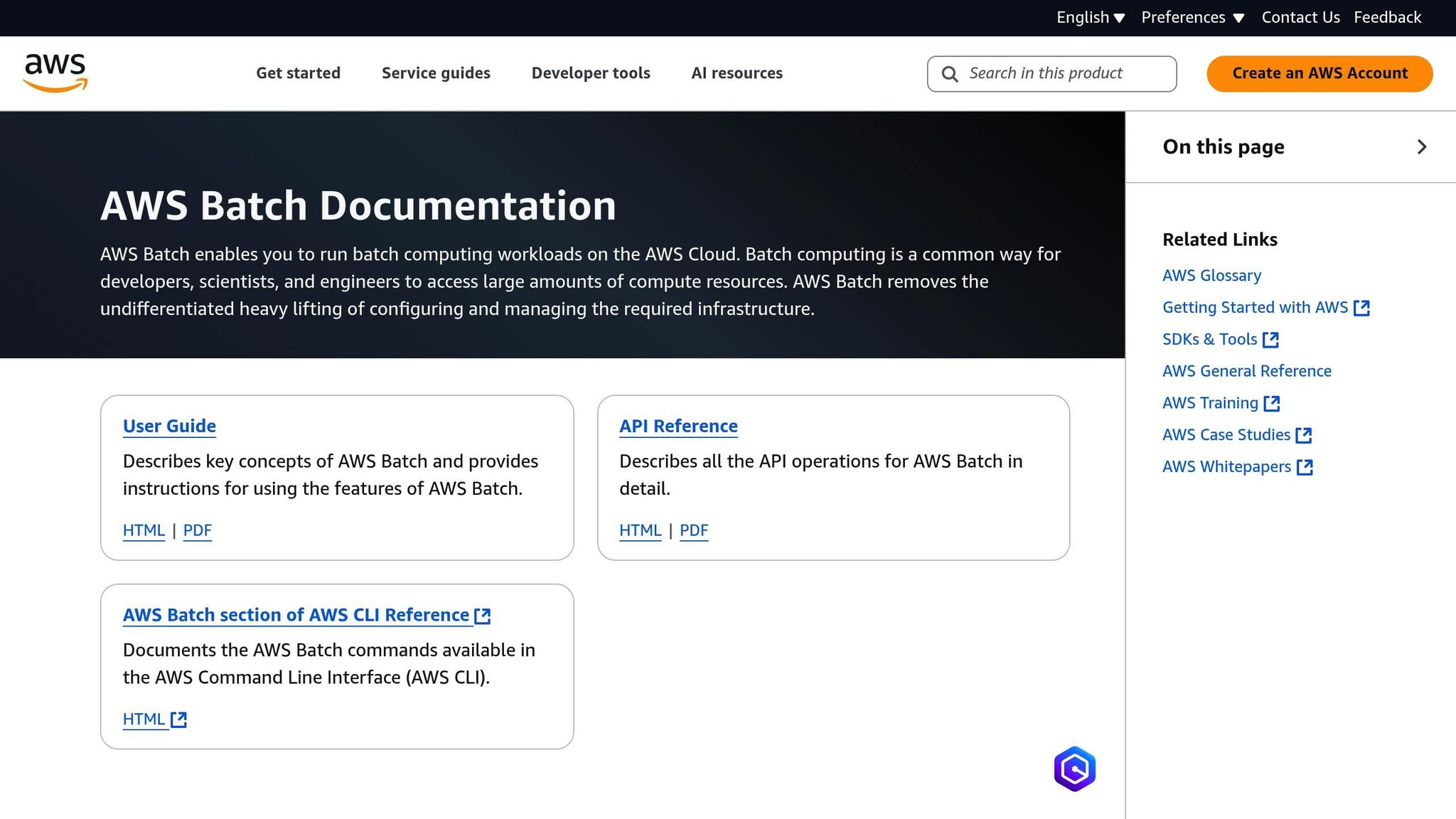
AWS Batch is designed to handle large-scale computational workloads without requiring you to manage complex infrastructure. It automatically scales compute resources based on job requirements, making it a go-to solution for scheduled, resource-intensive data transformations.
"AWS Batch is a service that enables scientists and engineers to run computational workloads at virtually any scale without requiring them to manage a complex architecture." – AWS HPC Blog
Core Capabilities and Architecture
AWS Batch operates by organizing work into job queues, which feed into compute environments. When a job is submitted, AWS Batch takes care of scheduling, resource allocation, and execution. It supports both containerized applications and traditional batch scripts, offering flexibility for various data transformation needs. By leveraging a mix of EC2 Spot and On-Demand instances, AWS Batch optimizes resource usage, ensuring cost-effective performance. These features make it well-suited for handling diverse workloads.
Latency and Performance Characteristics
AWS Batch focuses on maximizing throughput rather than minimizing latency, which means it’s not the best choice for real-time processing. For shorter tasks, scheduling overhead might outweigh the actual runtime. To improve efficiency, group tasks into jobs that run for 3–5 minutes or longer.
Scaling and Resource Management
Scaling is one of AWS Batch's strengths, offering two main compute options:
- AWS Fargate: Ideal for jobs that need to start quickly (under 30 seconds) and require up to 4 vCPUs and 30 GiB of memory.
- Amazon EC2: Offers more control and supports higher resource demands, including GPUs and custom AMIs. This is perfect for high-throughput workloads or jobs requiring specialized Linux configurations.
This flexibility allows you to fine-tune your batch processing pipelines for both speed and resource optimization.
Integration Patterns with AWS Services
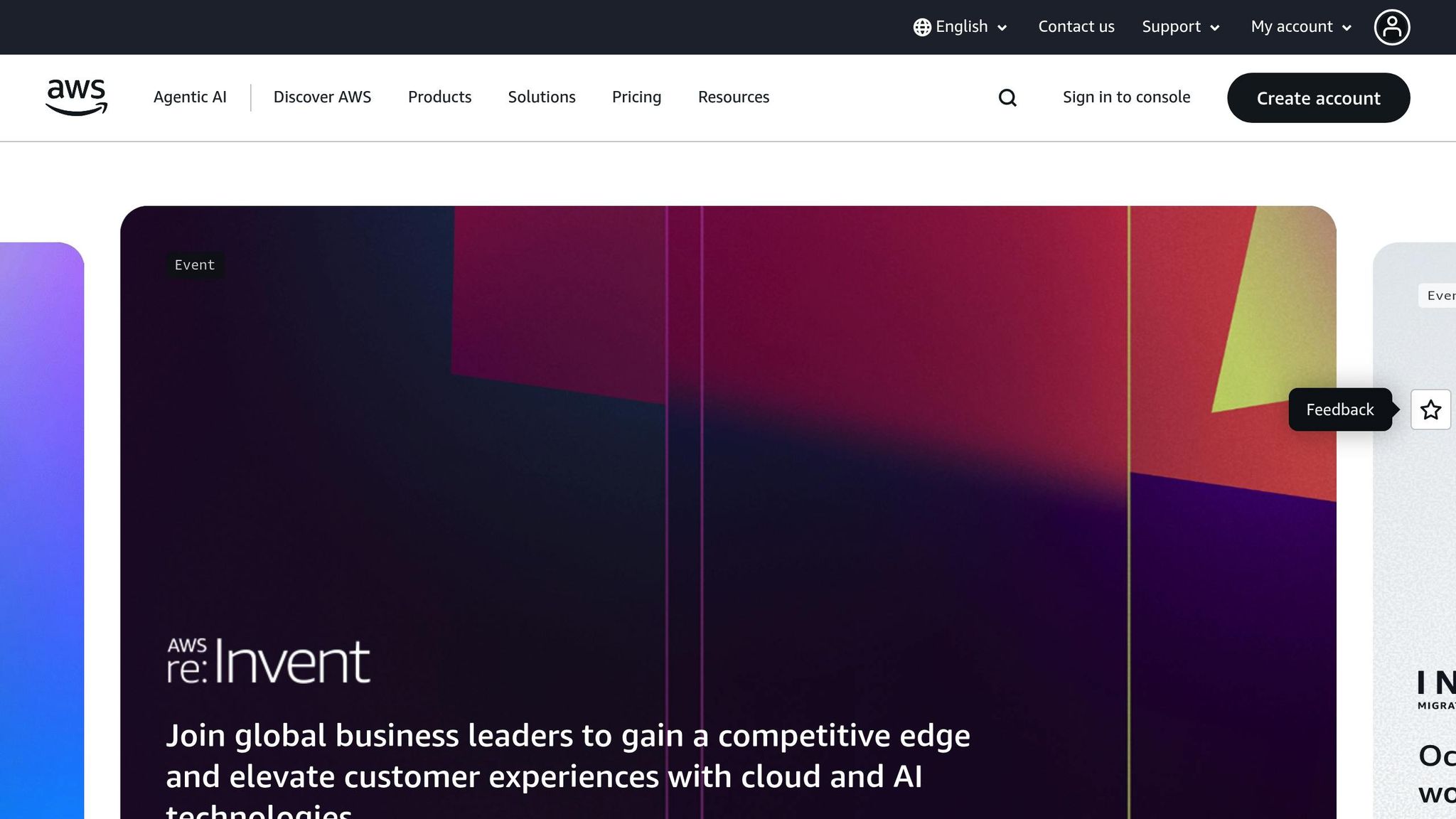
AWS Batch integrates seamlessly with other AWS services, enabling robust data transformation workflows:
- Amazon S3: Acts as the primary storage layer, scaling automatically to meet demand.
- Amazon DynamoDB: Can be used to manage job inputs or stage task arguments.
- Amazon EventBridge: Triggers Lambda functions in response to Batch events, such as Spot Instance interruptions, ensuring interrupted jobs are resubmitted to On-Demand queues.
These integrations simplify data ingestion, storage, and task coordination, making AWS Batch a powerful tool for building efficient workflows.
Monitoring and Operational Considerations
Effective monitoring is key to maintaining reliable operations. Here’s how you can stay on top of your jobs:
- CloudWatch Logs: Use the CloudWatch Agent to push system and ECS logs for diagnosing runtime issues.
- Structured Metrics: CloudWatch Embedded Metrics Format helps track performance in a structured way.
- Automated Retries: AWS Batch supports custom retry strategies, such as up to five retries for host failures, while immediately aborting for application errors.
When using a mix of Spot and On-Demand instances, diversify instance types, sizes, or Availability Zones in On-Demand environments to avoid resource contention.
Cost Optimization Strategies
AWS Batch keeps costs down by efficiently managing resources and incorporating Spot Instances. For cost-sensitive jobs, enable 1–3 automated retries to maintain queue priority when Spot Instances are interrupted. For longer-running or highly reliable jobs, On-Demand instances provide greater consistency, though at a higher cost. Balancing these options is key to achieving both reliability and cost-efficiency.
2. AWS Lambda
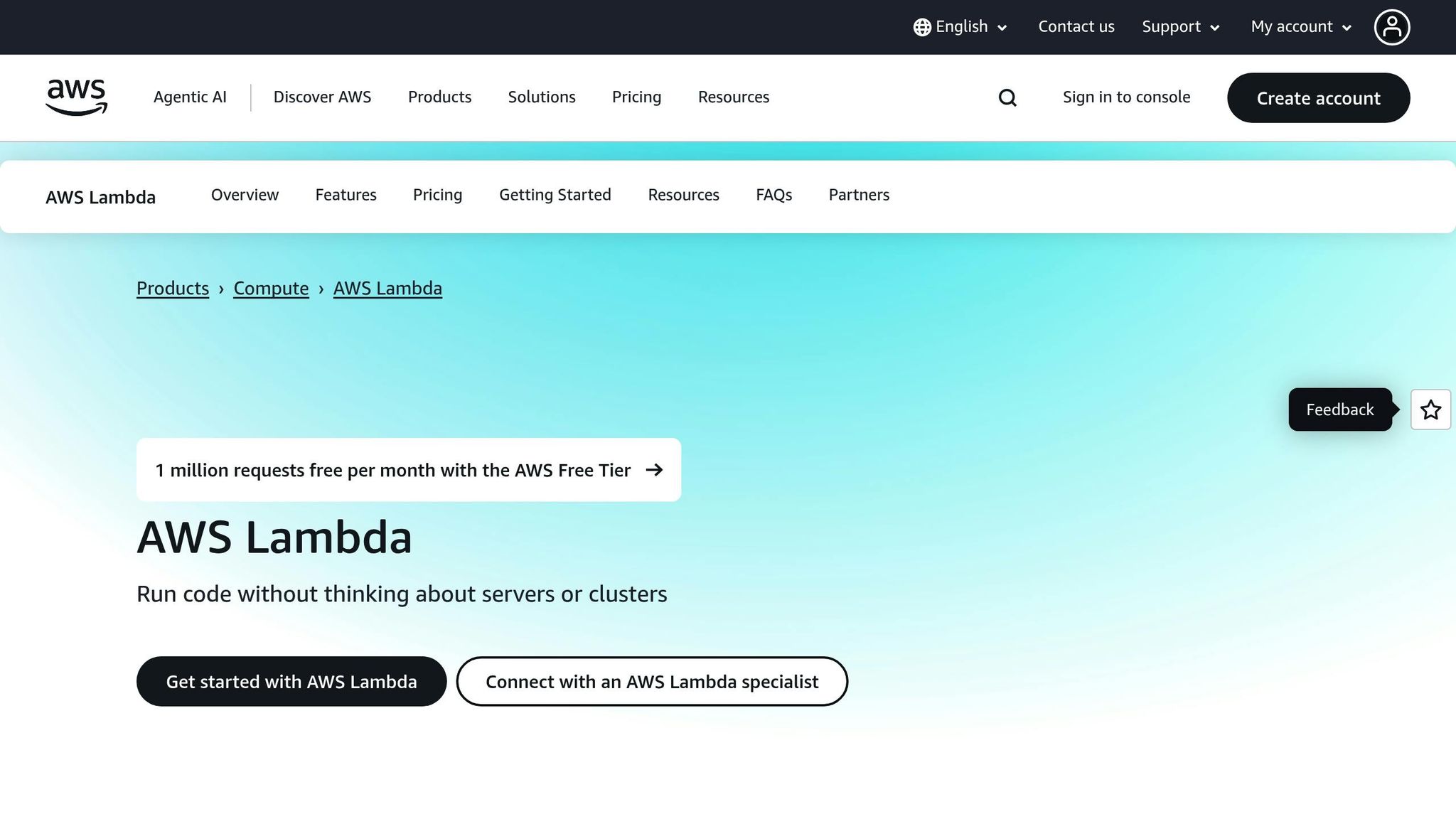
AWS Lambda offers a serverless computing solution designed to handle data transformation tasks without the need to manage infrastructure. This allows developers to concentrate solely on their code. It’s particularly well-suited for event-driven workflows, whether in batch or streaming scenarios.
Event-Driven Processing Architecture
Lambda relies on event source mappings to process records from services like Kinesis, DynamoDB, MSK, and SQS. These mappings actively poll for new messages and trigger functions using batches of records. Records are processed in batches, with the function being invoked once thresholds for batch size, batching window, or payload size (up to 6 MB) are met.
Latency and Performance Characteristics
When dealing with stream processing, Lambda dynamically scales its event pollers based on the incoming message volume. For example, it assigns a dedicated event poller to each Kafka partition, capable of handling up to 5 MB per second and supporting concurrent function invocations. However, cold starts - occurring after periods of inactivity - can add a few seconds of latency. To minimize this, you can enable provisioned concurrency, which keeps instances pre-warmed. Additionally, setting MaximumBatchingWindowInSeconds to 0 in Kafka event source mappings ensures Lambda starts processing the next batch immediately after the current one, reducing delays.
Error Handling and Reliability
Lambda’s error-handling mechanism ensures reliability. If a function encounters an error while processing a batch, the event source mapping retries the entire batch until it either succeeds or expires. This approach pauses processing for the affected shard, maintaining in-order processing. Such robust error handling is complemented by Lambda's smooth integration with AWS data services.
Integration Patterns with AWS Services
Lambda seamlessly integrates with key AWS services through event source mappings. For instance, when paired with Kinesis Data Streams using enhanced fan-out, Lambda can process streaming data with latencies as low as 70 milliseconds or better. This enables efficient, near real-time data transformations. Additionally, services like DynamoDB, MSK, and SQS also work effectively as event sources, making Lambda a versatile choice for various data processing needs.
3. Amazon Kinesis Data Streams
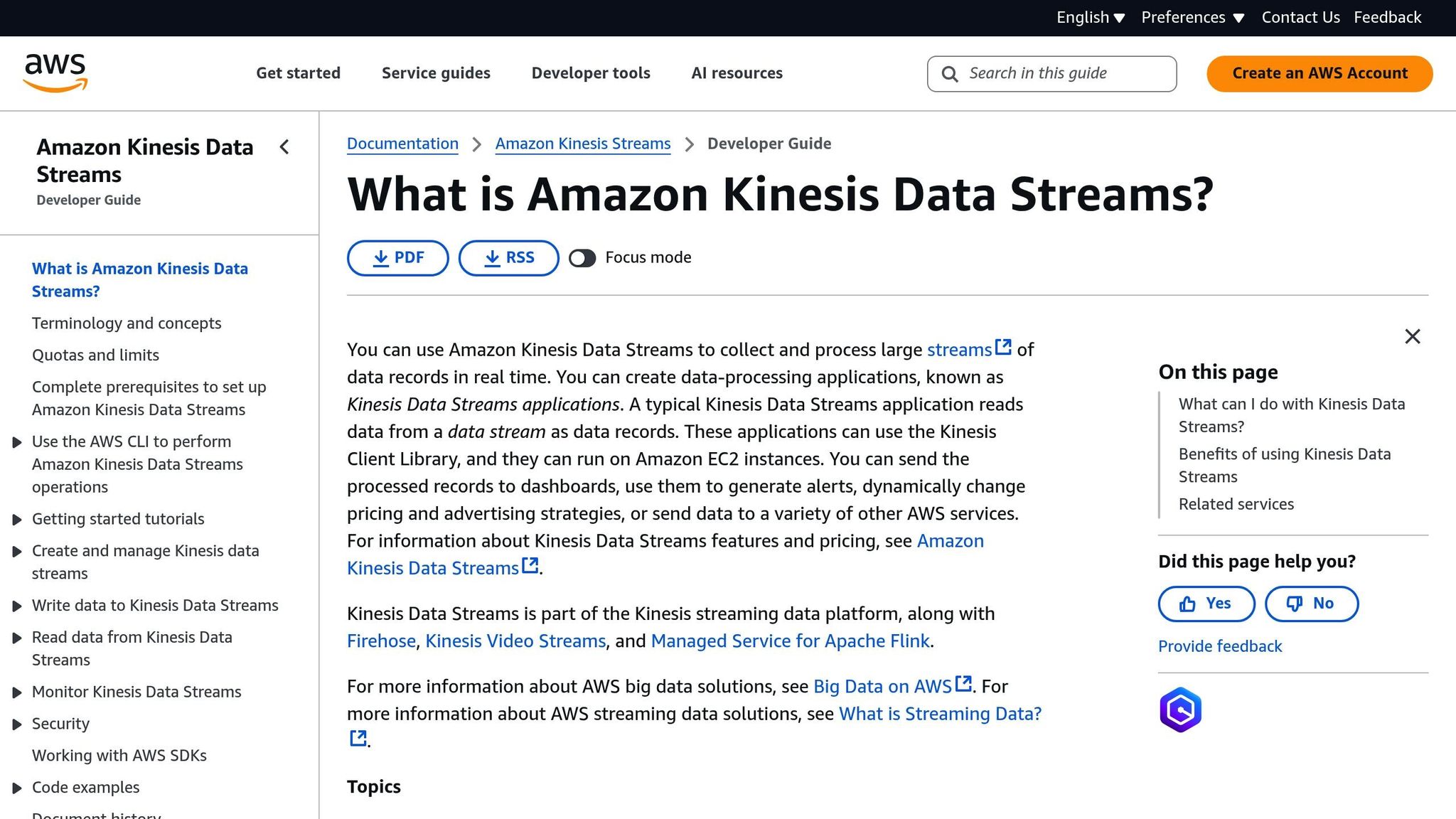
Amazon Kinesis Data Streams is a fully managed service designed for capturing, storing, and processing streaming data in real time. Unlike AWS Lambda’s event-driven model, Kinesis Data Streams acts as a persistent data pipeline, continuously managing data from multiple producers and delivering it to various consumers. This makes it an essential tool for real-time data workflows.
Stream Architecture and Sharding
At the core of Kinesis Data Streams is its shard-based architecture. Shards are the building blocks of capacity and throughput. Each shard can handle up to 1,000 records or 1 MB per second for data ingestion and supports 2 MB per second for data retrieval per consumer (or per consumer with enhanced fan-out).
Incoming data is distributed across shards using a partition key, which ensures that records with the same key are processed in order. If your data volume grows beyond the capacity of your current shards, you can scale dynamically by splitting overloaded shards or merging underutilized ones. This flexibility ensures that the stream adapts to your workload.
Real-Time Processing Capabilities
Kinesis Data Streams is built for high-speed data handling with sub-second latency. It stores data for a configurable retention period, ranging from 24 hours to 7 days, giving you the flexibility to process data at your own pace or replay it as needed. This retention capability is crucial for applications where data durability and reliability are non-negotiable.
The platform supports multiple consumption patterns at the same time. For instance, batch jobs and real-time analytics applications can read from the same stream independently. Each consumer maintains its position in the stream using checkpointing, ensuring smooth and uninterrupted processing. To further enhance performance, the enhanced fan-out feature provides additional scalability and reduces latency.
Enhanced Fan-Out for Low Latency
Enhanced fan-out assigns each consumer its own dedicated throughput, eliminating the need for polling. This feature significantly reduces latency, bringing it down from around 200 milliseconds with standard consumers to approximately 70 milliseconds. This is especially useful when multiple downstream applications need to process the same data stream independently. These low-latency capabilities make Kinesis Data Streams a natural fit for complex, real-time workflows within AWS.
Integration with the AWS Ecosystem
Kinesis Data Streams works seamlessly with other AWS services, enabling comprehensive data processing pipelines. For instance:
- Amazon Kinesis Analytics allows you to run SQL-based transformations on streaming data.
- AWS Glue can catalog and transform the data for analytics.
- Amazon EMR supports batch processing of accumulated stream data.
For operational visibility, Kinesis Data Streams integrates with Amazon CloudWatch, providing metrics like incoming and outgoing record counts, iterator age, and throughput usage. These insights help with proactive scaling and identifying performance issues.
Security is another cornerstone of the service. With AWS Identity and Access Management (IAM), you can define granular access controls, specifying which applications can produce or consume data. This is particularly useful for multi-tenant setups, where different teams share the same Kinesis infrastructure but need strict data isolation.
4. Amazon Kinesis Data Firehose
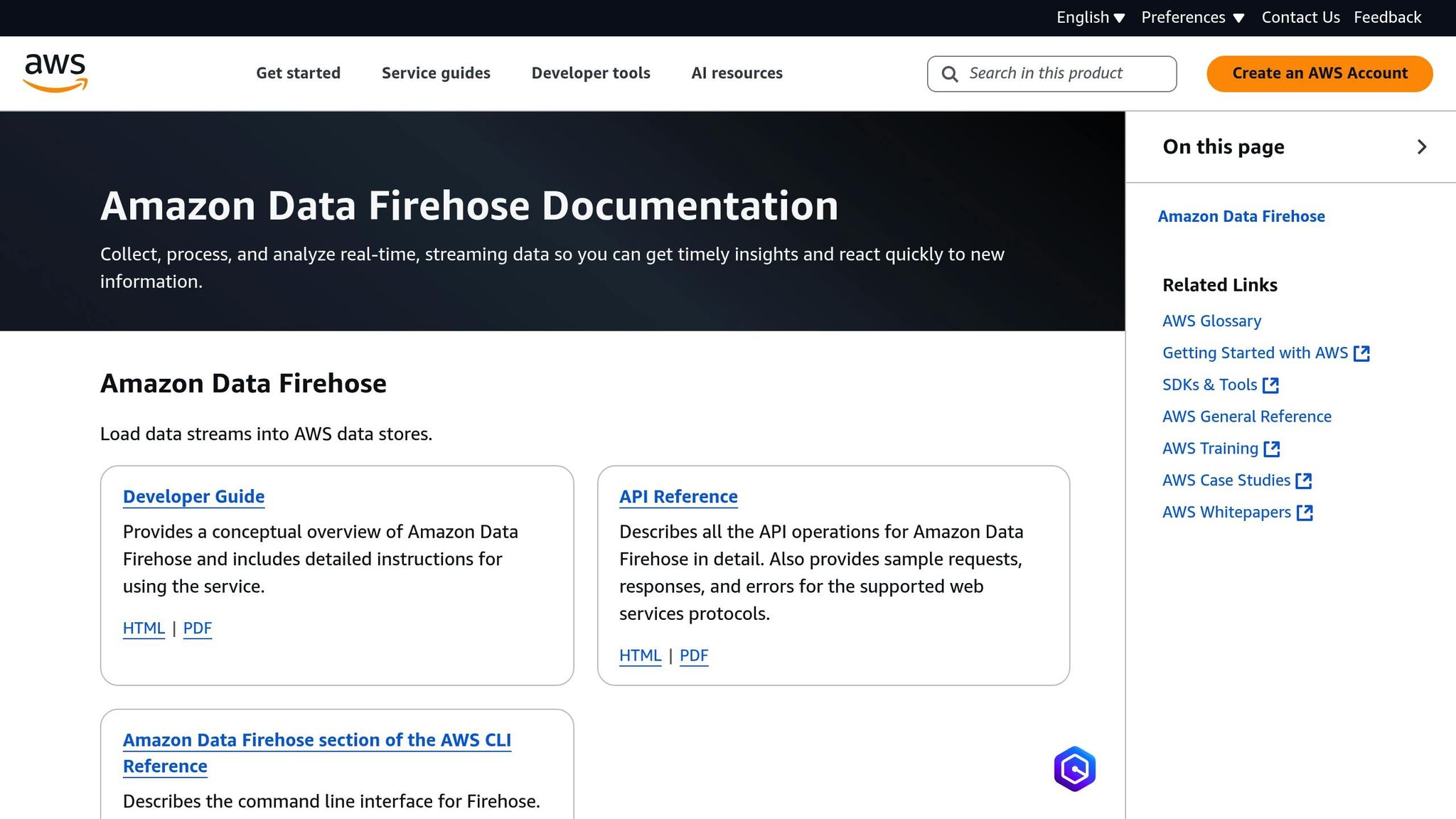
Amazon Kinesis Data Firehose serves as a streamlined solution for delivering and transforming streaming data directly to various data stores and analytics tools. Unlike Kinesis Data Streams, Firehose simplifies the process by automating both data ingestion and transformation, making it a fully managed service.
One of its standout features is the built-in data transformation capability, which leverages AWS Lambda for real-time custom processing. This means you can perform tasks like format conversion or adding extra details to records while the data is in transit - no manual steps required. By handling these transformations seamlessly, Kinesis Data Firehose becomes an excellent choice for scenarios where real-time processing and minimal data staging are priorities. It’s a practical and efficient tool within the AWS ecosystem for ensuring your data is ready for analysis as soon as it arrives.
sbb-itb-6210c22
5. Amazon Managed Streaming for Apache Kafka (MSK)
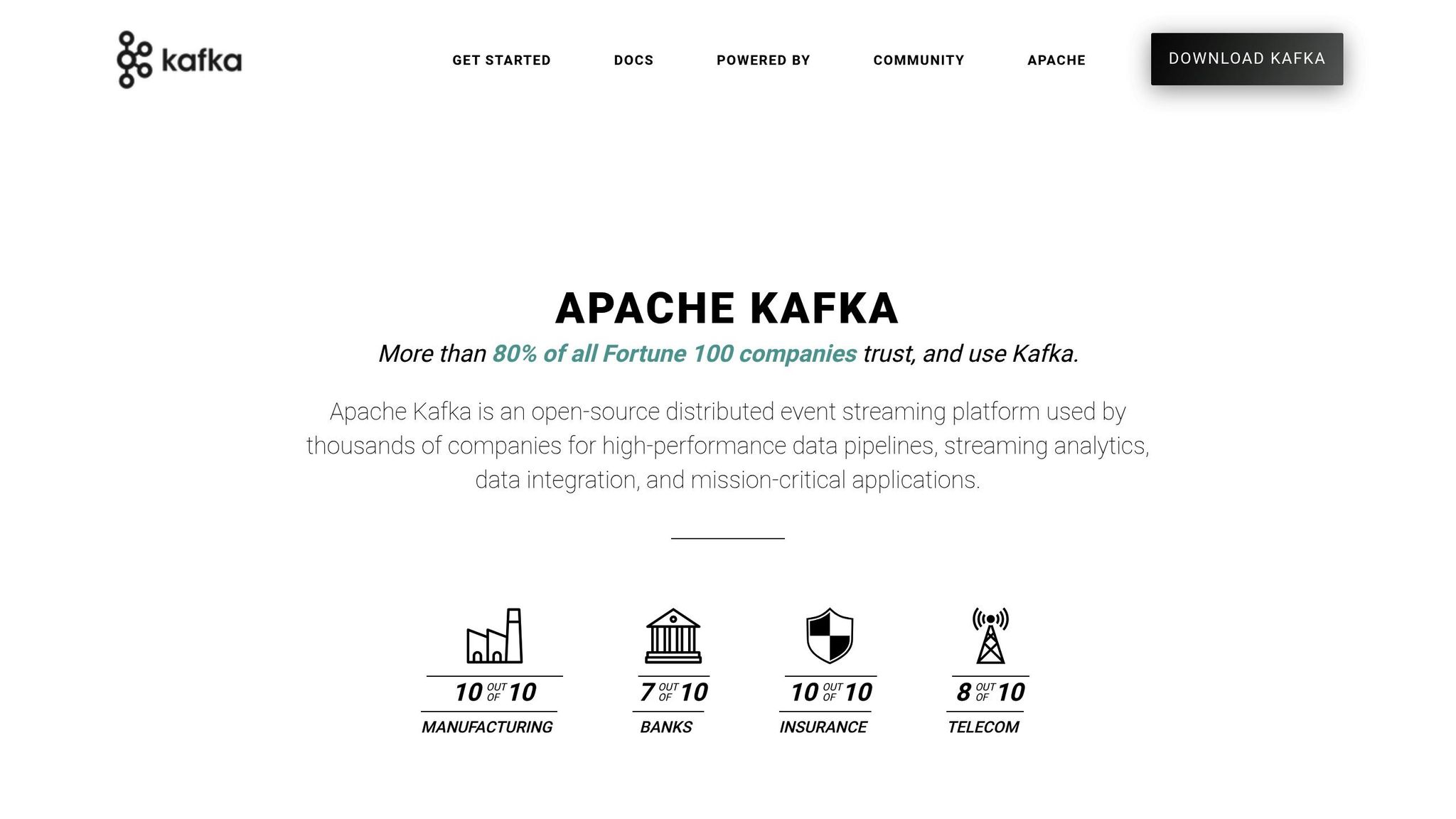
Amazon Managed Streaming for Apache Kafka (MSK) is a fully managed service that takes care of Apache Kafka clusters, making it easier for organizations to leverage Kafka's high-throughput data streaming capabilities without the hassle of manual cluster management.
Use Cases and Applications
MSK is a great fit for scenarios that require durable message storage, message replay, or complex event processing. This makes it particularly useful for event sourcing architectures, audit logging, and situations where multiple downstream systems need to consume the same data stream. Additionally, it supports workflows that involve multiple stages of data processing, ensuring smooth data flow throughout.
Latency Performance
MSK is designed to deliver low latency for both publishing and consuming messages. By using provisioned clusters with larger instance types and carefully distributing partitions across consumer groups, MSK ensures consistent performance. It also manages broker operations to distribute partitions evenly across availability zones, providing a solid foundation for scalability and seamless integration.
Scaling Capabilities
Scalability is another strength of MSK. It supports both vertical scaling (upgrading instance types) and horizontal scaling (adding more brokers). For serverless clusters, MSK can automatically adjust capacity based on workload demands. Message retention periods can also be customized, with MSK handling the storage infrastructure to match your needs.
AWS Service Integration
MSK integrates with a wide range of AWS services through MSK Connect, which offers managed connectors for services like Amazon S3, Amazon RDS, and Amazon OpenSearch. These connectors simplify the creation of data pipelines, eliminating the need for custom integration code and speeding up development.
Security and Monitoring
When it comes to security and monitoring, MSK has you covered. It works seamlessly with CloudWatch for metrics, CloudTrail for API logging, and IAM for access control. Additionally, it supports Apache Kafka's native ACLs, allowing for detailed management of topics and consumer group permissions.
Comparison Summary
AWS offers a range of tools tailored for different data transformation needs, each with its own strengths and limitations. Choosing the right one depends on factors like latency, data volume, processing complexity, and operational preferences. Here's a closer look at how these services stack up.
AWS Batch stands out when handling compute-heavy batch processing tasks. It's ideal for large datasets that need processing on a schedule or via triggers. However, its reliance on scheduling means it's not suitable for real-time workflows.
AWS Lambda is perfect for lightweight, event-driven tasks. Its serverless design allows for quick deployment and cost-effective operation, especially for intermittent workloads. That said, its 15-minute execution cap and memory constraints make it less effective for large-scale or complex batch processing.
Amazon Kinesis Data Streams provides unmatched flexibility for real-time stream processing. Its low latency and ability to handle custom logic through user-defined applications make it a top choice for complex use cases. However, managing shard scaling and consumer applications can add operational overhead.
Amazon Kinesis Data Firehose simplifies data streaming by automating delivery to destinations like S3, Redshift, or OpenSearch. It scales automatically and requires minimal management. Yet, its transformation capabilities are limited compared to fully custom solutions, and it offers less control over processing logic.
Amazon MSK (Managed Streaming for Apache Kafka) shines in scenarios requiring high throughput and advanced stream processing. It supports complex event handling, message replay, and multiple consumer groups. The trade-off is the added complexity and cost of managing Kafka clusters.
| Tool | Best Use Cases | Latency | Scalability | AWS Integration |
|---|---|---|---|---|
| AWS Batch | Large-scale ETL, scheduled jobs, compute-heavy tasks | Higher (minutes to hours) | Horizontal scaling with job queues | Works with S3, RDS, CloudWatch |
| AWS Lambda | Event-driven processing, API responses, lightweight tasks | Low (milliseconds) | Automatic scaling up to 1,000 concurrent executions | Integrates with 200+ AWS services |
| Kinesis Data Streams | Real-time analytics, custom stream processing | Very low (sub-second) | Manual shard scaling, up to 1,000 records/second per shard | AWS SDK and Kinesis Client Library support |
| Kinesis Data Firehose | Data lake ingestion, simple transformations, delivery | Medium (~60 seconds) | Automatic scaling based on throughput | Direct delivery to S3, Redshift, OpenSearch, Splunk |
| Amazon MSK | High-throughput streaming, complex event handling | Low (milliseconds) | Horizontal and vertical scaling with managed brokers | MSK Connect for S3, RDS, OpenSearch integration |
Your decision will also hinge on costs. AWS Lambda's pay-per-execution model is cost-efficient for workloads that aren't constant. On the other hand, Kinesis Data Streams and MSK offer more predictable costs for steady streaming needs. For large-scale batch jobs, AWS Batch pricing depends on how well you optimize EC2 instances and scheduling.
Conclusion
Choosing the right AWS tool for data transformation depends on understanding your specific needs and aligning them with the strengths of each service. Here's a quick recap of what each tool brings to the table:
AWS Batch is best suited for handling large datasets and compute-intensive tasks that might run for hours or even days. It shines in large-scale ETL operations where immediate results aren't essential, thanks to its automatic scaling and cost-efficient resource management.
AWS Lambda excels in event-driven tasks that require fast responses. Its pay-per-execution model and ability to scale to thousands of concurrent executions make it a go-to for lightweight processing jobs.
When it comes to real-time streaming, Amazon Kinesis Data Streams offers high throughput and the ability to retain data for replays. It works well for high-volume, custom stream processing applications that involve complex logic.
Amazon Kinesis Data Firehose simplifies data streaming by automatically delivering data to destinations like S3, Redshift, or OpenSearch Service. With built-in Lambda integration for basic transformations, it’s a great choice for straightforward data ingestion workflows.
For scenarios requiring Apache Kafka compatibility, Amazon MSK is the tool of choice. MSK Serverless automatically scales resources and supports low-latency, high-throughput applications with features like message replay and multiple consumer groups.
To make the best choice, focus on three main factors: latency needs (batch processing vs. real-time), complexity of transformations (basic vs. advanced logic), and operational preferences (fully managed vs. customizable). For cost-conscious decisions, consider Lambda for sporadic workloads, Batch for resource-heavy jobs, or Kinesis On-Demand for flexible streaming pricing.
AWS tools can also work together to build end-to-end data pipelines. For instance, you could use MSK for initial data ingestion, Lambda for real-time transformations, Firehose for delivering data to your lake or warehouse, and Batch for periodic heavy processing. Together, these services can create a seamless and efficient data transformation workflow tailored to your needs.
FAQs
How do I choose between AWS Batch and AWS Lambda for data transformation?
When deciding between AWS Batch and AWS Lambda, the best choice hinges on the specific requirements of your data transformation tasks.
AWS Lambda shines in real-time, event-driven scenarios. It’s a great fit for short-duration tasks like processing data streams as they arrive or reacting to specific triggers. Its automatic scaling and pay-per-use pricing make it an efficient option for handling these types of workloads.
AWS Batch, in contrast, is built for large-scale, resource-heavy batch processing. It’s the go-to option for tasks like processing massive datasets, executing scheduled ETL workflows, or managing complex, long-running computations.
The key factors to weigh include the duration and complexity of your workload, as well as whether your needs lean toward real-time processing or batch execution.
What are the main differences in scalability and latency between Amazon Kinesis Data Streams and Amazon Kinesis Data Firehose?
Amazon Kinesis Data Streams (KDS) stands out for its high scalability and low latency, making it a strong choice for handling massive data flows. With KDS, you can manage shards directly, where each shard supports up to 5 read transactions per second and a data read rate of 2 MB per second. This setup allows KDS to process gigabytes of data per second, with latency typically ranging between 70 and 200 milliseconds.
In contrast, Kinesis Data Firehose focuses on simplicity and near real-time data processing. It automatically adjusts to incoming data throughput, eliminating the need for manual scaling. However, its latency is slightly higher, usually measured in seconds. This makes Firehose a great option for scenarios where a small trade-off in latency is acceptable for the benefit of ease of use and automatic scaling.
What makes Amazon MSK suitable for high-throughput streaming, and how does it compare to other AWS streaming tools?
Amazon MSK is built to handle high-throughput streaming, thanks to features like express brokers. These brokers can deliver up to three times the throughput per broker, scale operations 20 times faster, and cut recovery times significantly. On top of that, the integration with AWS Graviton3 processors boosts throughput by up to 29% while lowering costs, making it a powerful option for managing large-scale workloads.
When compared to other AWS streaming tools like Kinesis, Amazon MSK stands out with its scalability for handling massive data volumes. It also offers more control through Kafka-compatible data streams and is well-suited for complex, enterprise-level streaming applications. These capabilities make it a strong contender for businesses that need reliable and adaptable streaming solutions.
